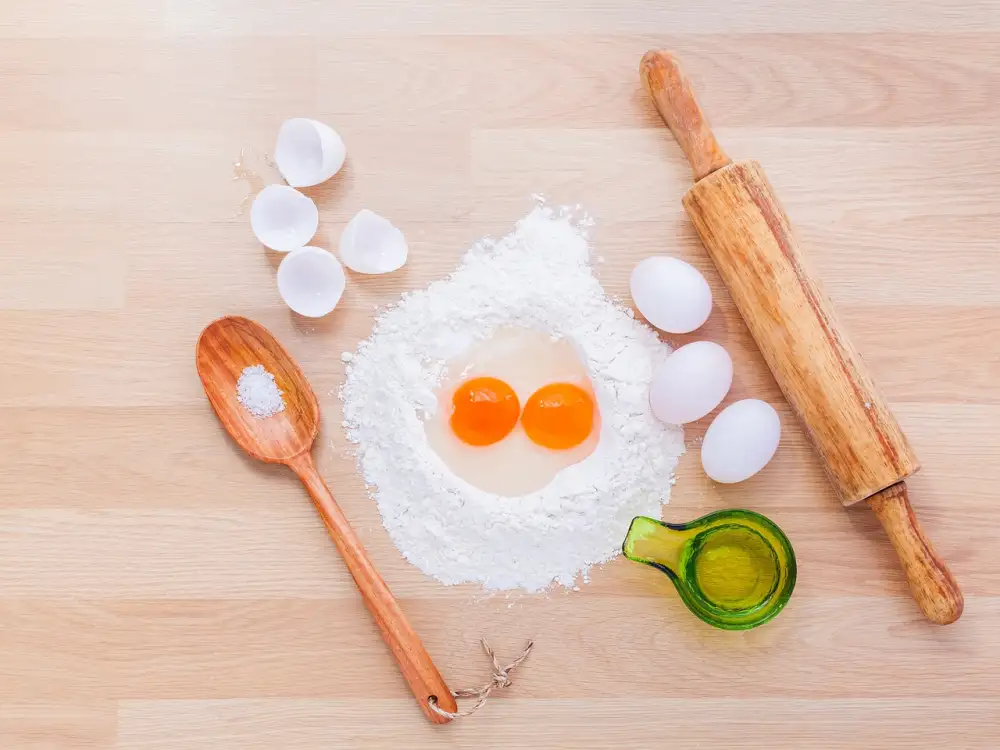Master the Art of Perfect Pizza Dough: Unleash Your Culinary Creativity with Freshly Made Dough

- Understanding the key ingredients required for making pizza dough
- Step-by-step instructions on how to prepare pizza dough from scratch
- Tips and tricks for achieving the perfect texture and consistency of pizza dough
- Exploring different types of pizza dough variations and their unique characteristics
- The role of fermentation in enhancing the flavor and texture of pizza dough
- Creative ways to use leftover pizza dough for other delectable dishes
- Expert recommendations for storing and freezing pizza dough for future use
Pizza dough is the foundation of every great pizza. It is the canvas upon which all the delicious toppings and flavors come to life. The quality of the dough can make or break a pizza, so mastering the art of making perfect pizza dough is essential for any aspiring home chef. The right combination of ingredients and techniques can result in a crust that is light, airy, and chewy, with just the right amount of crispness. In this article, we will explore the importance of pizza dough in creating mouthwatering pizzas and guide you through the process of making your own dough from scratch. Get ready to unleash your culinary creativity and elevate your pizza game to new heights!
Understanding the key ingredients required for making pizza dough
Understanding the key ingredients required for making pizza dough is essential in creating the perfect base for your delicious pizzas. The main ingredients include flour, water, yeast, salt, and olive oil. Flour provides structure and texture to the dough, while water activates the yeast and helps in gluten formation. Yeast is responsible for fermentation and gives the dough its airy texture. Salt enhances the flavor of the dough, and olive oil adds richness and moisture. By understanding these key ingredients and their roles, you can ensure that your pizza dough turns out light, flavorful, and perfectly balanced.
Step-by-step instructions on how to prepare pizza dough from scratch
To prepare pizza dough from scratch, follow these simple steps:
1. In a large mixing bowl, combine 2 ½ cups of all-purpose flour, 1 teaspoon of salt, and 1 teaspoon of sugar.
2. Create a well in the center of the dry ingredients and add 1 cup of warm water and 2 teaspoons of active dry yeast. Let it sit for about 5 minutes until the yeast activates and becomes frothy.
3. Gradually incorporate the flour into the wet mixture using a wooden spoon or your hands. Once the dough starts to come together, transfer it onto a floured surface.
4. Knead the dough for about 8-10 minutes until it becomes smooth and elastic. Add more flour if needed to prevent sticking.
5. Shape the dough into a ball and place it in a greased bowl. Cover with a clean kitchen towel or plastic wrap and let it rise in a warm area for about an hour or until doubled in size.
6. After rising, punch down the dough to release any air bubbles that may have formed. Divide it into smaller portions depending on your desired pizza size.
7. Roll out each portion into thin rounds or stretch them by hand to create your desired crust thickness.
Now you have freshly made pizza dough ready to be topped with your favorite ingredients and baked to perfection!
Tips and tricks for achieving the perfect texture and consistency of pizza dough
To achieve the perfect texture and consistency of pizza dough, here are some tips and tricks to keep in mind. Firstly, use high-quality flour with a high protein content, such as bread flour or Tipo 00 flour. This will give your dough the necessary structure and elasticity. Secondly, ensure that your yeast is fresh and active by proofing it in warm water with a pinch of sugar before adding it to the flour mixture. This step helps activate the yeast and ensures a good rise. Additionally, knead the dough thoroughly for at least 10 minutes to develop gluten strands that will give your crust its desired chewiness. It's also important to let the dough rest and rise in a warm place for at least an hour or until it doubles in size. This allows the flavors to develop and gives the dough its lightness. Lastly, when rolling out the dough, do so gently to avoid tearing or overworking it. By following these tips and tricks, you'll be able to achieve a perfectly textured pizza dough every time you make it at home.
Exploring different types of pizza dough variations and their unique characteristics
When it comes to pizza dough, there is no one-size-fits-all approach. The beauty of making your own dough is that you have the freedom to experiment with different variations and create a pizza that suits your taste buds perfectly.
One popular variation is thin crust dough, which results in a crispy and light base. This type of dough requires less rising time and is perfect for those who prefer a more delicate texture.
On the other hand, if you're a fan of thick and chewy crusts, then deep dish dough is the way to go. This dough typically contains more yeast and requires a longer rising time, resulting in a pillowy crust that can hold up to hearty toppings.
For those looking for a healthier alternative, whole wheat or multigrain dough is an excellent choice. These variations incorporate nutritious flours like whole wheat or spelt, adding a nutty flavor and extra fiber to your pizza.
If you're feeling adventurous, you can even try gluten-free dough options using alternative flours like almond or rice flour. These variations are perfect for individuals with gluten sensitivities or those looking to explore new flavors.
Each type of pizza dough variation brings its own unique characteristics and flavors to the table. Whether you prefer thin and crispy or thick and chewy crusts, experimenting with different types of dough will allow you to unleash your culinary creativity and create pizzas that are truly one-of-a-kind.
The role of fermentation in enhancing the flavor and texture of pizza dough
The role of fermentation in enhancing the flavor and texture of pizza dough is crucial. Fermentation is a process where the yeast in the dough consumes sugars, producing carbon dioxide gas, which creates air pockets in the dough. This results in a light and airy texture.
During fermentation, enzymes are also released, breaking down complex carbohydrates into simpler sugars. This not only adds sweetness to the dough but also enhances its flavor profile.
Fermentation also allows gluten strands to develop fully, giving the dough its elasticity and chewiness. The longer the fermentation period, the more developed the gluten becomes, resulting in a more flavorful and tender crust.
To achieve optimal fermentation, it is important to let the dough rise at room temperature for an extended period. This can range from several hours to overnight in the refrigerator. The slower fermentation process allows for better flavor development and a more digestible crust.
By understanding and harnessing the power of fermentation, you can elevate your pizza dough to new heights of deliciousness. So don't rush the process - give your dough ample time to ferment and watch as it transforms into a masterpiece of flavor and texture.
Creative ways to use leftover pizza dough for other delectable dishes
Creative Ways to Use Leftover Pizza Dough
Don't let your leftover pizza dough go to waste! There are plenty of creative ways to repurpose it into other delectable dishes. Here are a few ideas:
1. Breadsticks: Roll out the dough, brush with garlic butter, and sprinkle with parmesan cheese. Bake until golden brown for a delicious side dish or appetizer.
2. Calzones: Stuff the dough with your favorite fillings like cheese, vegetables, and meats. Fold it over and seal the edges before baking until crispy and golden.
3. Pretzels: Shape the dough into pretzel twists or knots, then boil briefly in water mixed with baking soda. Bake until golden brown and serve with mustard or cheese dip.
4. Stromboli: Layer the dough with deli meats, cheeses, and vegetables, then roll it up tightly like a jelly roll. Bake until golden brown for a savory meal on-the-go.
5. Cinnamon Rolls: Roll out the dough, spread with melted butter, cinnamon, and sugar. Roll it up tightly and slice into rounds before baking until fluffy and fragrant.
6. Flatbread: Roll out the dough thinly and top with your favorite ingredients like pesto, tomatoes, mozzarella cheese, and fresh herbs. Bake until crispy for a quick and easy snack or appetizer.
7. Fried Dough Balls: Cut the dough into small pieces and deep fry until puffed and golden brown. Serve them dusted with powdered sugar or dipped in chocolate sauce for a sweet treat.
With these creative ideas, you can transform your leftover pizza dough into new culinary delights that will impress your family and friends. So next time you have some extra dough on hand, don't hesitate to get creative in the kitchen!
Expert recommendations for storing and freezing pizza dough for future use
To ensure that you always have freshly made pizza dough on hand, it's important to know the best methods for storing and freezing it. Once you have prepared your dough, allow it to rise fully before dividing it into individual portions. Wrap each portion tightly in plastic wrap or place them in airtight containers to prevent any moisture from getting in.
For short-term storage, refrigerate the wrapped or containerized dough for up to 24 hours. This will help develop more flavor and improve the texture of the dough. When you're ready to use it, simply remove the dough from the refrigerator and let it come to room temperature before shaping and baking.
If you want to store your pizza dough for longer periods, freezing is the way to go. After wrapping or containerizing the portions, place them in freezer bags or wrap them tightly with aluminum foil. Label each package with the date so you can keep track of its freshness.
Frozen pizza dough can be stored for up to three months without losing its quality. When you're ready to use it, transfer a portion from the freezer to the refrigerator and let it thaw overnight. Once thawed, bring the dough to room temperature before shaping and baking.
Remember that once frozen dough has been thawed, it should not be refrozen. So make sure to only thaw what you need for each baking session.
By following these expert recommendations for storing and freezing pizza dough, you can enjoy homemade pizzas anytime without having to go through the entire preparation process every time!
In conclusion, mastering the art of perfect pizza dough opens up a world of culinary possibilities. With just a few simple ingredients and some patience, you can create delicious pizzas right in the comfort of your own home. The versatility of pizza dough allows you to experiment with different toppings and flavors, making each creation uniquely yours. And the best part? It's surprisingly simple! So why not unleash your culinary creativity and embrace the freshness of homemade pizza dough? Your taste buds will thank you!
Published: 29. 11. 2023
Category: Food



